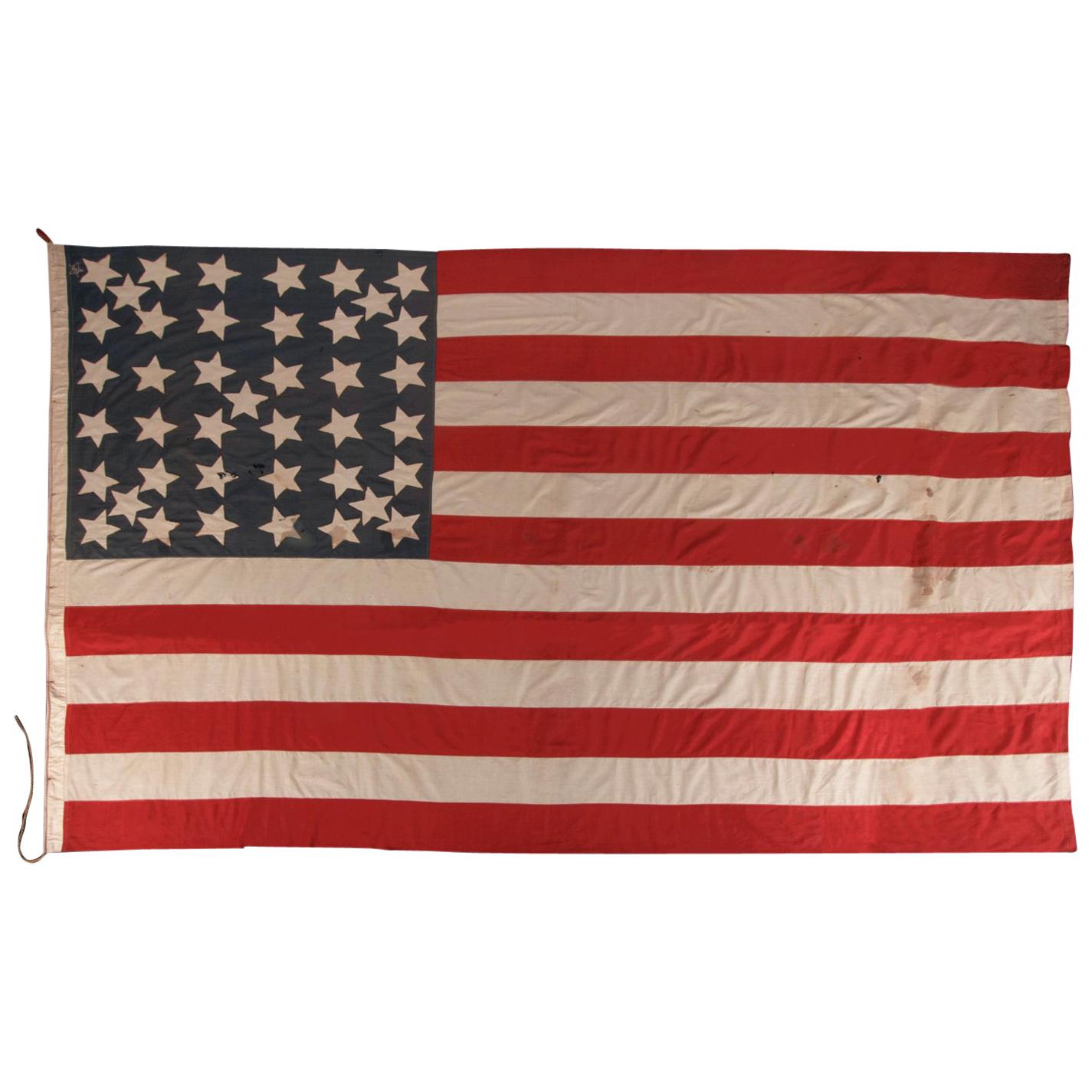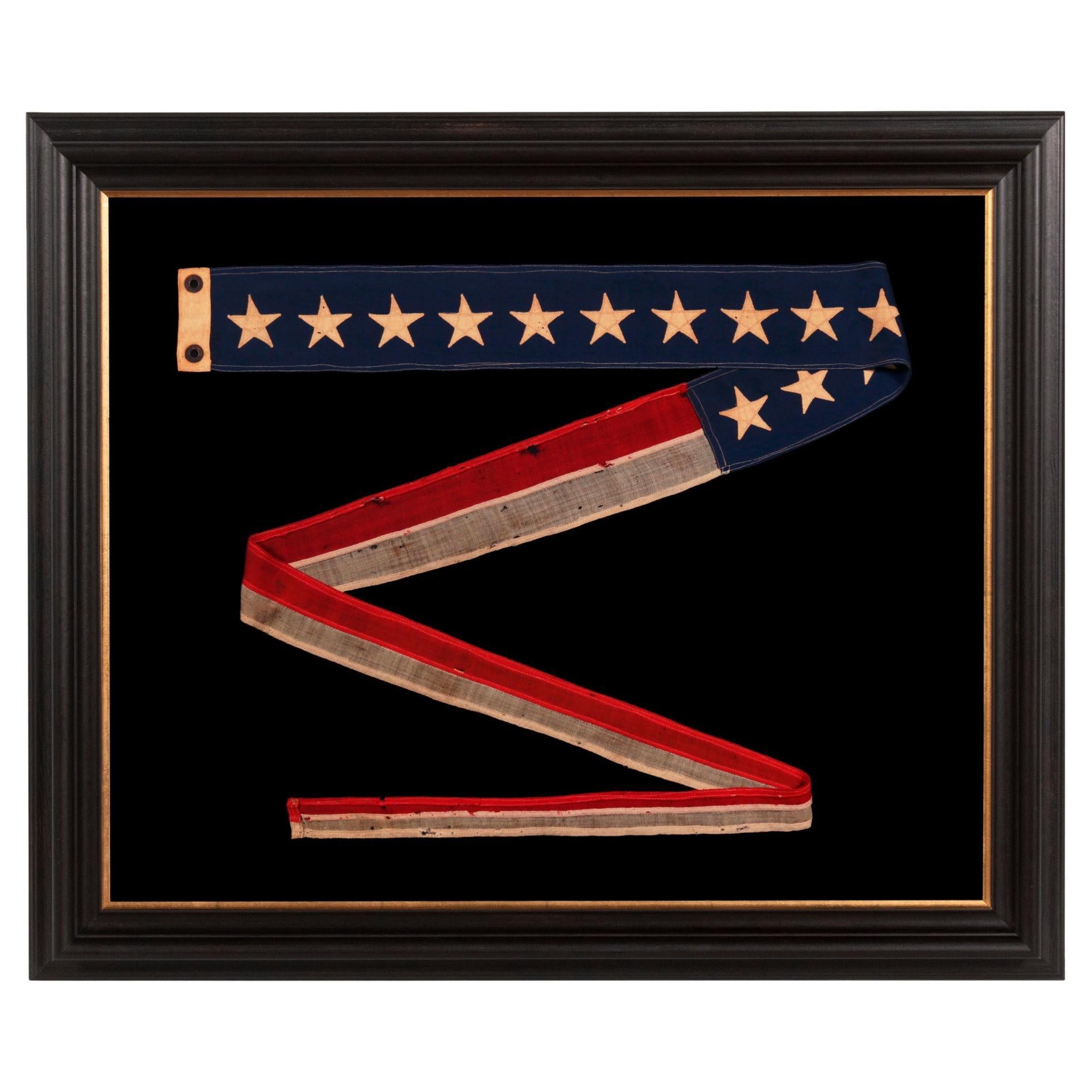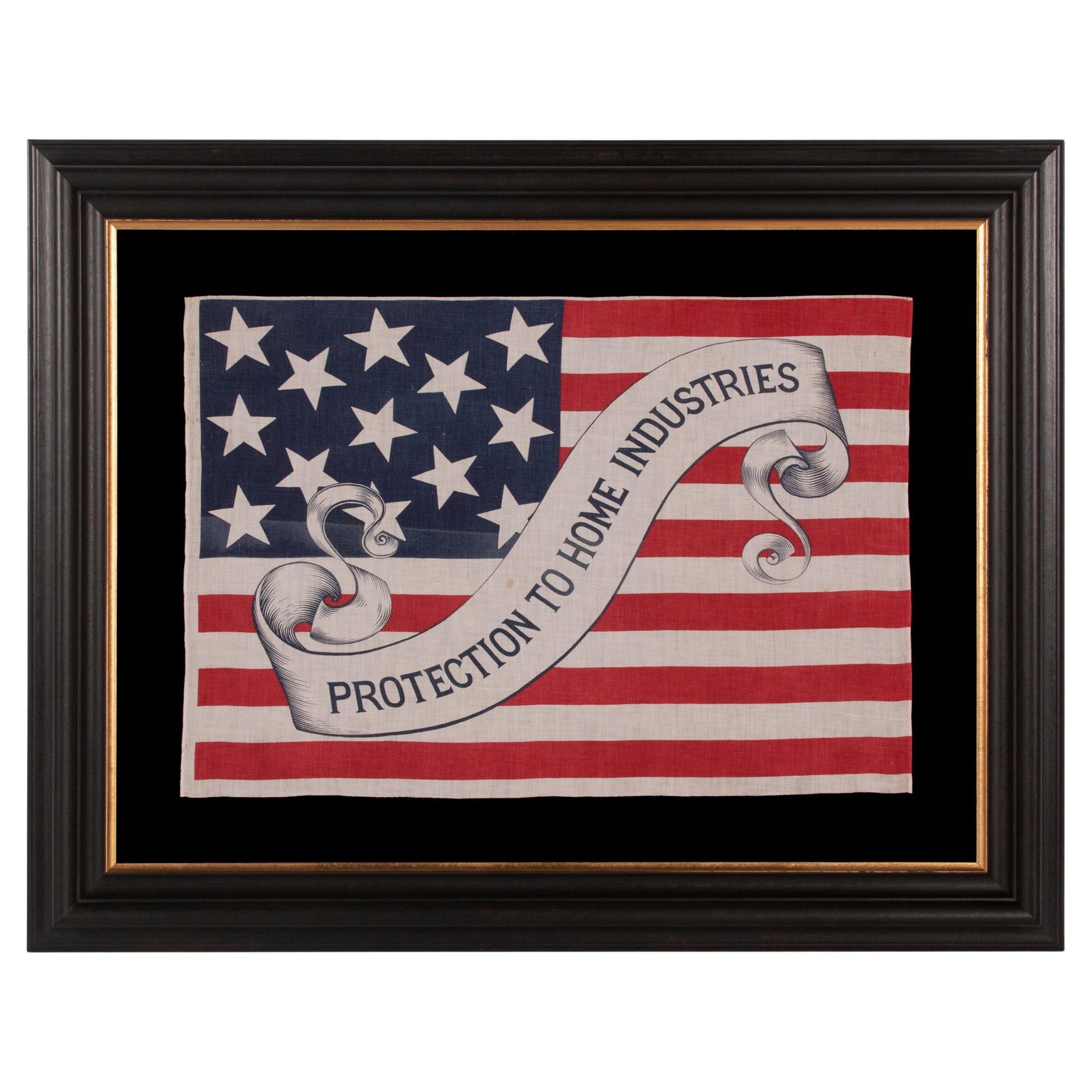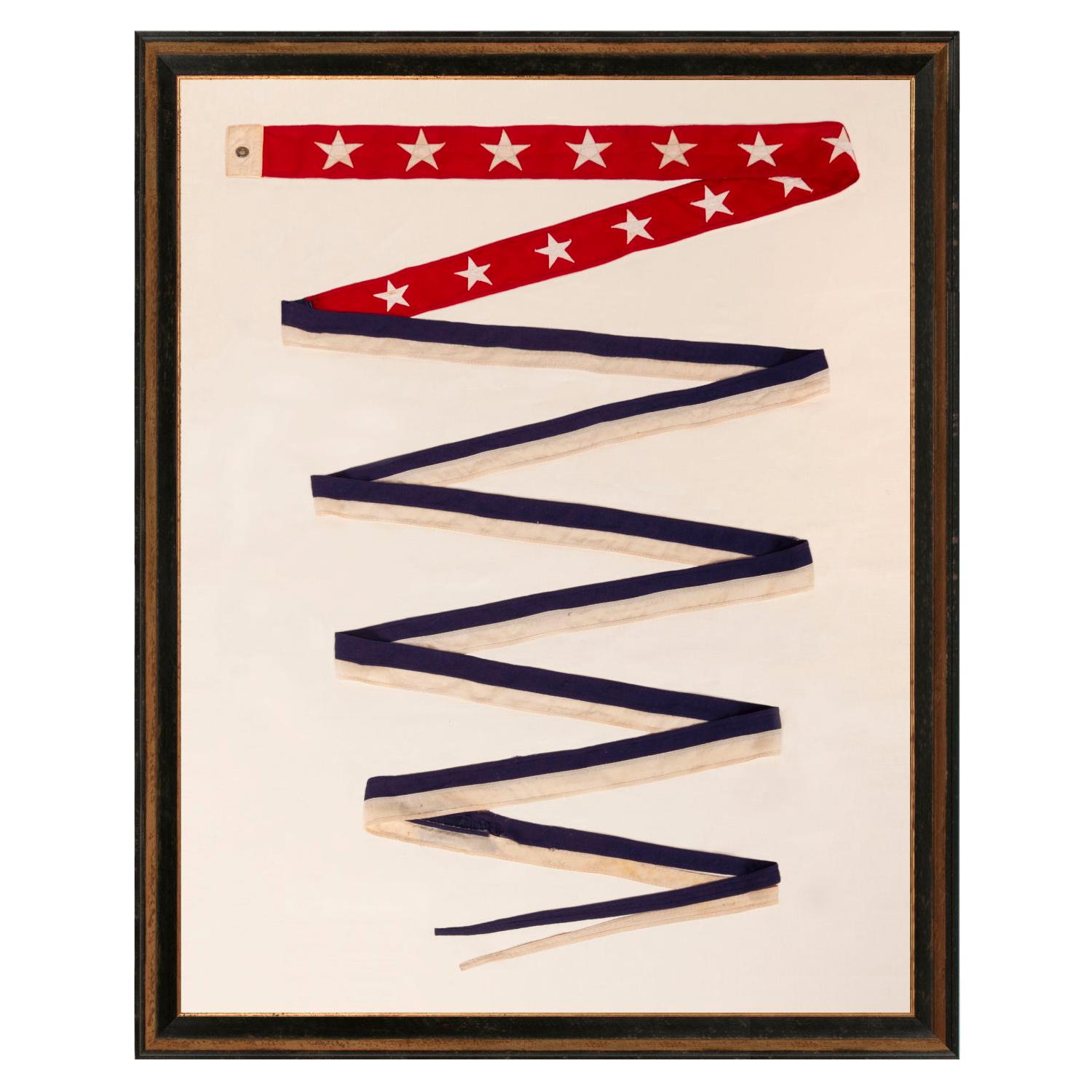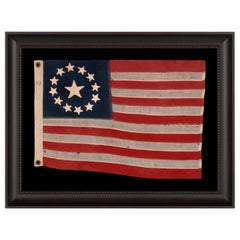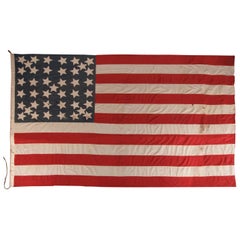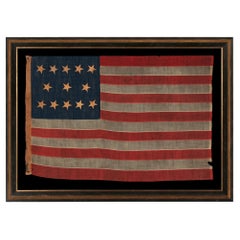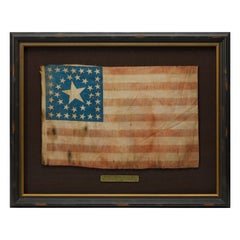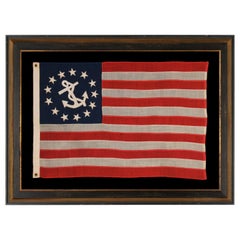
American Private Yacht Flag with 13 Stars
View Similar Items
Want more images or videos?
Request additional images or videos from the seller
1 of 6
American Private Yacht Flag with 13 Stars
About the Item
- Dimensions:Height: 36.5 in (92.71 cm)Width: 48.5 in (123.19 cm)Depth: 2.5 in (6.35 cm)
- Materials and Techniques:
- Place of Origin:
- Period:
- Date of Manufacture:1895-1926
- Condition:See Item Description.
- Seller Location:York County, PA
- Reference Number:Seller: 13j-15151stDibs: LU849714357442
About the Seller
5.0
Recognized Seller
These prestigious sellers are industry leaders and represent the highest echelon for item quality and design.
Established in 1991
1stDibs seller since 2008
61 sales on 1stDibs
Typical response time: 10 hours
More From This SellerView All
- 13 Star American Flag with Hand-Sewn Stars in the 3rd Maryland PatternLocated in York County, PA13 hand sewn stars in a circular version of what is known as the 3rd Maryland pattern, with an especially large center star, a flag with especially tiny scale among those with pieced-and-sewn construction, exceptionally rare, made circa 1890: 13 star flags have been flown throughout our nation’s history for a variety of purposes. They were hoisted at patriotic events, including Lafayette’s visit in 1824-25, the celebration of the centennial of American independence in 1876, and the sesquicentennial in 1926. They were displayed during the Civil War, to reference past struggles for American liberty and victory over oppression, and were used by 19th century politicians while campaigning for the same reason. As the number of stars grew with the addition of new states, it became more and more difficult to fit their full complement on a small flag. The stars would, by necessity, have to become smaller, which made it more and more difficult to view them from a distance as individual objects. The fear was that too many of them close together would become as one white mass and distort the ability to identify American ships on the open seas. Keeping the count low allowed for better visibility. For this reason the U.S. Navy flew 13 star flags on small boats. Some private ship owners mirrored this practice and flew 13 star flags during the same period as the Navy. Flag experts disagree about the precisely when the Navy began to revert to 13 stars and other low counts. Some feel that the use of 13 star flags never stopped, which seems to be supported by depictions of ships in period artwork. This was, of course, the original number of stars on the first American national flag, by way of the First Flag Act of 1777, and equal to the number of original colonies that became states. Any American flag that has previously been official remains so according to the flag acts, so it remains perfectly acceptable to fly 13 star flags today by way of congressional law. Since there was no official star configuration until the 20th century (1912 specifically, beginning with the 48 star count), the stars on 13 star flags may appear in any one of a host of configurations. Some of these are more rare and desirable than others. The stars of this particular flag are arranged in what has come to be known as the "3rd Maryland Pattern." This configuration, whether oval or circular, is appreciated both for its visual appeal and the scarcity of its use. a circular wreath of 12 with a single star in the center. The name comes from a flag that resides at the Maryland State Capitol in Annapolis, long thought to have been present with General Daniel Morgan at the Battle of Cowpens in 1781. According to legend, the flag was supposed to have been carried by Color Sergeant William Batchelor of the 3rd Maryland Light Infantry and was donated to the State of Maryland by Batchelor's descendants. The story was disproved in the 1970's, however, following an examination by the late flag expert Grace Rogers Cooper of the Smithsonian, who discovered that the Cowpens flag was, at the earliest, of Mexican War...Category
Antique 1890s American Political and Patriotic Memorabilia
MaterialsWool
Price Upon Request - 41 Stars In a Lineal Pattern With Offset Stars, Montana Statehood American FlagLocated in York County, PA41 STARS IN A LINEAL PATTERN WITH OFFSET STARS THAT CREATE A CROSSHATCH IN THE CORNERS AND CENTER, ONE OF THE RAREST STAR COUNTS AMONG SURVIVING FLAGS OF THE 19TH CENTURY, REFLECTS MONTANA STATEHOOD IN NOVEMBER, 1889, ACCURATE FOR JUST 3 DAYS: Numerous flags appeared with unofficial star counts in early America, produced by flag-makers in anticipation of the addition of more states. The 41 star flag...Category
Antique 1880s American Political and Patriotic Memorabilia
MaterialsCotton
- 13 Star Antique American Flag with Hand-Sewn Stars in 5-3-5 Pattern, ca 1861-65Located in York County, PAAntique American flag with 13 hand-sewn stars in an extremely rare lineal configuration of 5-3-5, probably made with the intent of use by local militia or private outfitting of a vol...Category
Antique 1860s American Political and Patriotic Memorabilia
MaterialsWool
- Commission Pennant with 13 Stars, like for Private Vessel, Ca 1892-1910Located in York County, PA8-Foot commission pennant with 13 stars, a unique example in my experience, likely produced for display on a private vessel, made circa 1892-1910. Commission pennants are the distinguishing mark of a commissioned U.S. Navy ship. Flown at the topmast, the typical American format is a long blue field, usually with a single row of white stars, although sometimes with their total divided into two rows, followed by two long stripes, red-over-white. A ship became commissioned when this pennant was hoisted. Flown during both times of peace and war, the only time the pennant is not flown is if a flag officer or civilian official was aboard and replaced it with their own flag. Sometimes the owners of private ships mimicked the use of Navy signals. Some seafaring men would have served in the Navy and become privy to various practices in that capacity. Others flew them purely for stylistic reasons, either on a regular basis or while the boat was dressed for special occasion. Hudson River steamers regularly flew pennants of this nature, as evidenced by period photography as well as the paintings of artists such as John and James Bard...Category
Antique Late 19th Century American Political and Patriotic Memorabilia
MaterialsWool
Price Upon Request - 34 Star American flag, Updated to 39 Stars, with Stars in a Great Star PatternLocated in York County, PA34 STARS IN A WHIMSICAL RENDITION OF THE GREAT STAR PATTERN, ON A CIVIL WAR PERIOD FLAG WITH A CORNFLOWER BLUE CANTON, UPDATED TO 39 STARS IN 1876 34 star American national flag with additional stars added and one of the most stunning graphic designs I have ever seen in early flag-making. The original pattern was comprised of a circle of 5 large stars, and triangular arms made of smaller stars. These are noticeable pointy and bent like the arms of a starfish. Made of cotton, the stars are hand-sewn and double-appliquéd to a fantastic, cornflower blue canton, a color common to Civil War uniforms...Category
Antique 1870s American Political and Patriotic Memorabilia
MaterialsCotton
- Outstanding 13 Star Hand-sewn American Private Yacht Flag, ca 1865-1885Located in York County, PAOUTSTANDING, 13 STAR, ANTIQUE AMERICAN PRIVATE YACHT ENSIGN WITH GREAT FOLK QUALITIES THAT INCLUDE AN UNUSUALLY WIDE ANCHOR AND A DECIDEDLY LOPSIDED RING OF 13 STARS; MADE DURING THE 2ND HALF OF THE 19TH CENTURY; ITS DEVICE HAND-SEWN AND SINGLE-APPLIQUÉD Private yacht ensigns were approved American signals for maritime use that allowed pleasure boats to bypass customs. Though the legislation that approved them was adopted prior to 1850, almost all such flags that one will encounter were sewn by electric machine and made during the 20th century. The unusual gems among surviving examples are those that are earlier and include hand-sewn elements. Even more rare are a select few with atypical graphics. Barely any fall into both of these categories at once. Take note of the anchor on this particular flag, wide a long horizontal crossbar (stock) that contributes to uncommonly wide stance. Set within a ring of stars that is decidedly lopsided, the result is as bold as it is endearingly whimsical—two of the best qualities in American folk art, a category in which this particular example can be filed. While I have owned 13 star private yacht flags that have displayed star and canted anchor devices that were somewhat larger and/or bolder than typical, I cannot recall any that were so graphically intriguing as this one. Brief History of Private Yacht Ensigns: The medallion configuration, 13-star, 13-stripe flag, with a canted center anchor was entered into official use in 1848, following an act of Congress, that made it the official signal for U.S. pleasure sailing vessels. The need for such a flag arose with the popularity of boating as a pastime for well-to-do Americans, and as a competitive sport, in addition to its longstanding utilitarian role as a vehicle of trade. In early America, all boats were subject to customs searches at every port. Without modern income tax, the federal government derived its revenues mostly from tariffs, so an accounting of foreign goods on ships was a critical venture. As yachting for pleasure became more prevalent, however, more and more time was spent searching boats that had no such inventory, wasting time for both customs officials and wealthy ship owners. John Cox Stevens, a former president of the Jockey Club and future founder of the Union League Club, became the New York Yacht Club’s Commodore upon its founding in 1845. In 1847 he approached the secretary of the treasury and suggested that something be done to streamline the customs process for non-trade vessels. In 1848, legislation passed Congress requiring registration of these boats, which could then fly the “American Yachting Signal” to bypass customs. This remained on the books until the 1980’s, when the 1848 legislation was revoked, but the use of flags in this design for decorative function continues to this day. 13 star flags have been flown throughout our nation’s history for a variety of purposes. In addition to their use on private yachts, they were hoisted at patriotic events, including Lafayette’s final visit in 1824-25, the celebration of the nation’s centennial in 1876, and the sesquicentennial in 1926. They were displayed during the Civil War, to reference past struggles for American liberty and victory over oppression, and were used by 19th century politicians while campaigning for the same reason. The U.S. Navy used the 13 star count on small boats until 1916, because it was easier to discern fewer stars at a distance on a small flag. Commercial flag-makers mirrored this practice and some private ships flew 13 star flags during the same period as the Navy. Construction: The stars and anchor are made of cotton, hand-sewn, and single-appliquéd. This means that they were applied to one side of the canton, then the blue fabric was cut from behind each star, folded over, and under-hemmed, so that one star could be viewed on both sides of the flag. I always find single-appliquéd stars more interesting, not only because they are evidence of a more difficult level of seam-work and stitching, but also because they are more visually intriguing. The two visible rows of hand-stitching emphasize their hand-sewn construction. For these reasons, single-appliquéd stars often appeal to connoisseurs of early American textiles...Category
Antique Mid-19th Century American Political and Patriotic Memorabilia
MaterialsWool
Price Upon Request
You May Also Like
- 39-Star Antique American Flag with 'Whimsical' Star Pattern, 1889Located in Colorado Springs, COThis is a 39-star unofficial American flag, handmade and printed on cotton. The flag dates to 1889 and has a unique history, thanks to its rare star-count. The flag’s canton is prin...Category
Antique 1880s American Political and Patriotic Memorabilia
MaterialsCotton
- 38-Star Antique American Flag with Unique Canton, circa 1876-1890Located in Colorado Springs, COThis is a striking 38-star American flag. The flag dates to 1876-1890, when Colorado (represented by the large star in the center of the flag’s canton) joined the Union as the 38th s...Category
Antique Late 19th Century American Political and Patriotic Memorabilia
MaterialsMuslin
- 46-Star American Flag Printed in Drum Star ConfigurationLocated in Colorado Springs, COThis is an original 46-Star American parade flag, celebrating Oklahoma statehood. Each star on the flag's canton represents a state in the Union at the time. The official flag design would update every July 4th, to include any new states added to the Union in the past year. Oklahoma, the 46th state, entered the Union on November 16, 1907. As such, this 46–star flag was the official flag of the United States from July 4, 1908, until July 4, 1912. The silk flag has a dark blue canton with 46 white printed stars. The stars are printed in an 7-8-8-8-8-7 row configuration, or “Drum design.” The flag design is completed with 13 alternating red and white stripes, each stripe representing one of the original thirteen colonies. The land that comprises Oklahoma today was added to the United States as part of the Louisiana Purchase of 1803. Throughout the 19th century, the U.S. government relocated Indian tribes from the southeastern United States to the area, and by 1900, over 30 Indian tribes had been moved to what was originally called the Indian Territories. At the same time, ranchers in Texas began to move into the area in search of new pasture lands. Although stipulations in the Indian Relocation Act agreed that the land would forever be Indian Territory, the promise of fertile farmland trumped the government’s promise of sovereignty. On April 22, 1889, they opened the land to settlement by homesteaders, creating a land run in which settlers, called “Boomers,” were allowed to cross the Texas or Arkansas border at a particular hour to claim homesteads. Settlers who illegally crossed the border earlier to stake prime land were called “sooners,” which eventually became the state’s nickname. Wagons and the Santa Fe railroad carried cartloads of men and women to blank town sites and building plots, creating ten thousand-people communities in a matter of days. The following year, the region was further divided into Indian Territory and Oklahoma Territory...Category
Vintage 1910s American Political and Patriotic Memorabilia
MaterialsSilk
- 31-Star Printed American Flag, Celebrating California Statehood, Circa 1850Located in Colorado Springs, COThis is a rare 31-star medallion printed American flag, celebrating the addition of California to the Union. The flag is printed on silk and has a spectacular “Great Star” canton pat...Category
Antique 1850s American Political and Patriotic Memorabilia
MaterialsSilk
- Antique Federal Eagle American 50 Star Flag with Brass Eagle Pole, 19th CenturyLocated in Oklahoma City, OKMonumental 50 star American Flag with antique Federal Eagle brass and wood pole. A patriotic piece suitable for any home. This set includes both ...Category
Antique 19th Century American Federal Political and Patriotic Memorabilia
MaterialsBrass, Bronze
$4,800 Sale Price20% Off - Rare Monumental 1890 Antique 42 Star United States of America FlagLocated in Dayton, OHMonumental fifteen foot 42 star American flag, circa 1889-1890. The 42-star flag is rare because only a limited number of 42-star flags were produced after Washington became a state on Nov. 11, 1889. But it takes a more intimate knowledge of flag trivia to know just why it happened this way. White stars are added to the blue field of the star-spangled banner on the Fourth of July after a state is admitted to the union. In the fall of 1889, several western territories became states. Dakota was admitted, and then split into North and South Dakota, on Nov. 2, 1889, which made them state and star numbers 39 and 40. Montana was named the 41st state on Nov. 8, followed by Washington, on Nov. 11. Only a few flag manufacturers began producing 42-star flags before the official addition of the 42nd star on July 4, 1890. Those who tried to jump the gun by being the first to produce an up-to-date flag were surprised when Idaho was admitted to the United States on July 3...Category
Antique 1890s American Classical Historical Memorabilia
MaterialsCotton
Recently Viewed
View AllMore Ways To Browse
American Flag 13
13 Star American Flag
Antique 13 Star American Flag
Applique Flag
Flag Bunting
American Flag Medallion
Antique Bunting Flags
Antique Patriotic Bunting
Ensign Flag
Victory Flag
13 Star American Flags
Liberty Cotton
Yacht Flag
Antique Yachting
Train Memorabilia
Antique Mirror Folk Art
Antique Folk Art Mirror
WWII Flags

